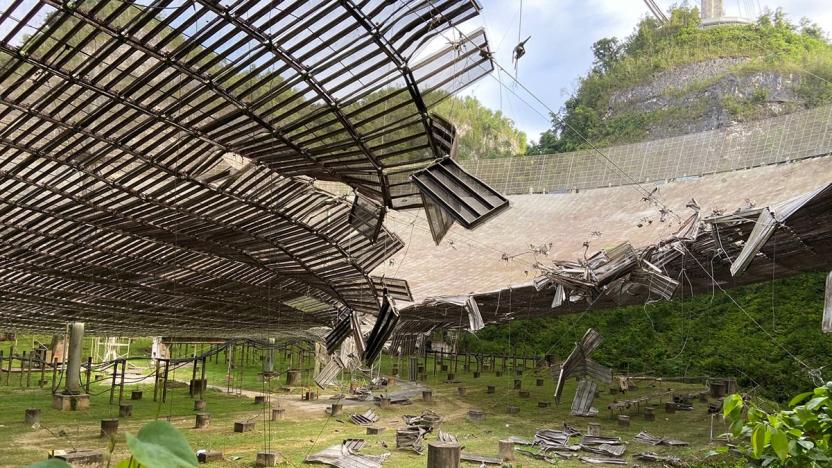University of Central Florida
Latest

DARPA helped make a sarcasm detector, because of course it did
Researchers from the University of Central Florida worked with DARPA to create a deep learning AI capable of understanding written sarcasm with a startling degree of accuracy.

Puerto Rico’s Arecibo radio telescope suffers serious damage
A broken cable damaged the Arecibo Observatory, the second-largest radio telescope in the world.

Scientists propose tethering asteroids to prevent Earth impacts
Scientists have proposed tethering asteroids together to prevent them from hitting Earth -- and without creating fragments.

Arecibo Observatory nets $19 million grant to search for dangerous asteroids
NASA has ensured the Arecibo Observatory in Puerto Rico can continue its search for near Earth objects (NEOs) that pose a threat to the planet with a $19 million grant. The fund was awarded to the University of Central Florida, which operates the observatory on behalf of the National Science Foundation.

EA Sports partners with UCF to create Innovation Lab program
EA Sports partnered with the University of Central Florida's FIEA (Florida Interactive Entertainment Academy) to create an "innovation lab" for students to work on projects in the games industry. EA Sports will offer additional internships for students, in which they will work on "the latest products for the latest platforms, using the latest tools and technologies." "By establishing pipelines directly into existing Orlando-based digital media businesses, including our local EA SPORTS studio, EA-Tiburon, we can keep creating jobs in the state of Florida," EA Sports VP and COO Daryl Holt said in the announcement. Florida Governor Rick Scott echoed Holt's sentiments. "Preparing Florida students for high-tech jobs, along with our state's competitive economic incentives, gives Florida an advantage over other states and ensures high-value businesses open their doors in our state, instead of somewhere else," he said. The relationship between EA Sports and FIEA dates back to March 2005, when former EA VP and COO Ben Noel became the executive director of the academic program.

Researchers create spinal cord connectors from human stem cells, heralding breakthrough
It's taken many years and more than a bit of brainpower, but researchers at the University of Central Florida have finally found a way to create neuromuscular connectors between muscle and spinal cord cells, using only stem cells. Led by bioengineer James Hickman, the team pulled off the feat with help from Brown University Professor Emeritus Herman Vandenburgh, who collected muscle stem cell samples from adult volunteers. After close examination, they then discovered that under the right conditions, these samples could be combined with spinal cord cells to form connectors, or neuromuscular junctions, which the brain uses to control the body's muscles. UCF's engineers say the technique, described in the December issue of the journal Biomaterials, marks a major breakthrough for the development of "human-on-a-chip" models -- systems that simulate organ functions and have the potential to drastically accelerate medical research and drug development. These junctions could also pay dividends for research on Lou Gehrig's disease or spinal cord injuries, though it remains unclear whether we can expect to see these benefits anytime soon.

University of Central Florida's miniature laser diode aims to speed up networking
The use of laser as a means of data transmission is hardly anything new, but the current crop of laser diodes can only handle so much stress, provided that they don't fail in the first place. Luckily, the geniuses over at the University of Central Florida are about to deliver a smaller yet more intense and more reliable diode, which will lead to many more potential applications even beyond the scope of networking -- think cheaper, more effective hair removal. Little is said about how Professor Dennis Deppe's team made this possible, but once they work out how to optimize the operating voltage for better efficiency, Deppe reckons we'll see diode-embedded high speed, high bandwidth cables in the shops in four or five years' time. Seriously, we'd do anything to keep our latency low for some HD gaming action.

New carbon nanotube aerogel is now the world's lightest solid material
Frozen smoke (read: aerogel) -- not to be confused with the stuff your Grandma uses to flavor her turkey -- is the world's lightest solid material, and it just keeps getting lighter. Researchers at the University of Central Florida have created a new form of the super material, known as multi-walled carbon nanotube (MWCNT) aerogel, that has a density of just four milligrams per cubic centimeter and can be used in sensors to detect pollutants and toxic substances, chemical reactors, and electronic components. Aerogels, which are known as the world's most effective insulators, have been around since the early 20th century, but most of these are fabricated from silicon dioxide. In order to produce the new aerogel, researchers removed the liquid from a "wet gel of well-dispersed pristine MWCNTs," creating a honeycomb structure with walls just 100-nanometers thick. The resulting material is an impressive and resilient electrical conductor that looks and acts less like frozen smoke and more like a burnt marshmallow. And now, you know. Check out the coverage link below for video.

Motion capture game teaches tween girls to avoid the come-ons of boys from the Metaverse
The University of Central Florida has been awarded a $434k grant to develop a video game for tween girls. The game, which is still in development, is apparently designed to allow girls to "practice" rejecting peer pressure from boys for sex and make outs. Of course, the only natural way to immerse the player in such a game is to put her into a motion capture suit, where her jittery marionette of an avatar is surrounded by the most diabolical 3D models of teenage males obtainable on that $434k budget -- if it was paid to Neal Stephenson in 1992. "It's a place to practice where there aren't any social consequences," says Professor Anne Norris, who is heading the project. But who will protect them from the psychological consequences, Anne? And will there be any escape from the meta-virus? Check out the unintentionally hilarious video after the break.

University of Central Florida's abstinence edu-game is just the best thing ever
Look, we really wanted to write a harsh diatribe about the University of Central Florida's federally-funded game development project: An Avatar-esque edu-game that teaches young girls to ignore the sexual advances of their contemporaries. We wanted to talk about all the things that $434,000 of taxpayer's money could have been spent on, or how silly of a concept a motion-controlled abstinence game really is. Unfortunately, our spite turned to pure, unbridled glee after watching this Fox News Report on the project. Between the news-friendly gaming lingo ("digital puppetry," "jumping into the skin," "interactors," etc.) and the contorted, soulless husks that comprise the game's cast of sexually aware characters, the video -- posted just after the jump -- is a comedy goldmine. Dig in, gang.









